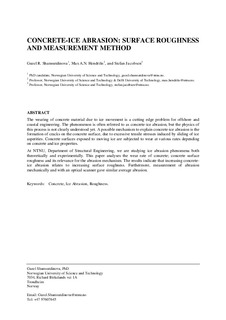| dc.contributor.author | Shamsutdinova, Guzel | |
| dc.contributor.author | Hendriks, Max | |
| dc.contributor.author | Jacobsen, Stefan | |
| dc.contributor.editor | Banthia, Nemkumar | |
| dc.date.accessioned | 2015-11-06T14:00:31Z | |
| dc.date.accessioned | 2016-03-01T10:14:58Z | |
| dc.date.available | 2015-11-06T14:00:31Z | |
| dc.date.available | 2016-03-01T10:14:58Z | |
| dc.date.issued | 2015 | |
| dc.identifier.citation | Banthia, Nemkumar [Eds.] ConMat 15 - Advances in construction materials - Procc 5th Int Conf on construction materials: performance innovations and structural implications 19-21 August 2015, Whistler, BC, Canada, University of British Columbia, 2015 | |
| dc.identifier.isbn | 978-0-88865-168-6 | |
| dc.identifier.uri | http://hdl.handle.net/11250/2381039 | |
| dc.description | | |
| dc.description.abstract | The wearing of concrete material due to ice movement is a cutting edge problem for offshore and coastal engineering. The phenomenon is often referred to as concrete-ice abrasion, but the physics of this process is not clearly understood yet. A possible mechanism to explain concrete-ice abrasion is the formation of cracks on the concrete surface, due to excessive tensile stresses induced by sliding of ice asperities. Concrete surfaces exposed to moving ice are subjected to wear at various rates depending on concrete and ice properties.
At NTNU, Department of Structural Engineering, we are studying ice abrasion phenomena both theoretically and experimentally. This paper analyses the wear rate of concrete; concrete surface roughness and its relevance for the abrasion mechanism. The results indicate that increasing concrete-ice abrasion relates to increasing surface roughness. Furthermore, measurement of abrasion mechanically and with an optical scanner gave similar average abrasion. | |
| dc.language.iso | eng | |
| dc.publisher | University of British Columbia Vancouver | |
| dc.title | CONCRETE-ICE ABRASION: SURFACE ROUGHNESS AND MEASUREMENT METHOD | |
| dc.type | Chapter | |
| dc.date.updated | 2015-11-06T14:00:31Z | |
| dc.source.journal | ConMat 15 - Advances in construction materials - Procc 5th Int Conf on construction materials: performance innovations and structural implications | |
| dc.identifier.cristin | 1286898 | |
| dc.description.localcode | Published paper | |
